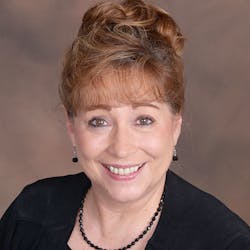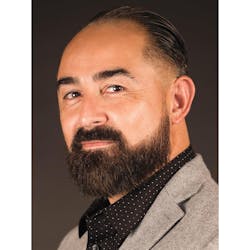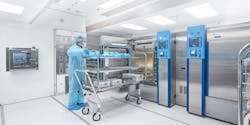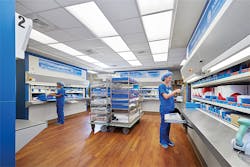One common thread woven throughout the ongoing COVID-19 public health emergency is flexibility.
Healthcare has faced multiple changes and challenges. Staff have adapted their schedules, workloads, workspaces, personal protective equipment (PPE) and practices to meet the needs of patient care and safety for all in hospitals, ORs and healthcare facilities.
Sterile Processing and Distribution (SPD) departments play an essential role in care and infection control in medical environments. SPD technicians must consistently achieve the highest standards and practices in reprocessing and delivering clean and sterile instruments, devices and equipment for safe use on patients undergoing surgical or critical care procedures.
The pandemic, however, has thrown many curve balls at healthcare and SPD. The impact is widespread, including declining elective surgeries, increased hygiene and cleaning safety measures, PPE shortages, schedule shifts or cuts and additional needs in other areas of care, to name a few. SPD professionals, though, have stepped up to the plate, changed the line-up and provided necessary services in SPD and other departments within their settings.
Work rotation, support
During the ensuing COVID-19 crisis, what are the biggest challenges in SPD departments, staffing and workplaces?
“Fear was evident in all of us from the onset of the pandemic,” Ferrer emphasized. “Our team focused on staying positive and diligent about the safety for ourselves, colleagues, visitors and our patients. Masking, social distancing and constant change in our work practices converted into our new norm. We are fortunate to have a strong, resilient team with many years of experience.”
She added, “Our biggest challenge was our fluctuating staffing needs. Our daily routines were tossed out and a new way of thinking, acting and working emerged. Work commitments were difficult for team members personally and professionally. School-age children were now at home learning remotely with parents now scrambling to find child care so they could go to work. As surgical volumes resume, we need to evaluate our FTE budget to fill the vacancies that transpired during the pandemic months.”
Jeff Paquet, CEO, mmic Medical Systems, observes a pause in improvements to SPD work settings as facilities remain focused on the crisis and care.
“The biggest challenges we have seen in the industry is that hospitals have largely put on hold capital improvement projects in SPD departments,” Paquet indicated. “Most renovations are being driven by deficiencies in workspaces or equipment. Against the backdrop of dealing with the challenges of the pandemic, SPD staff had to continue to do their jobs to the best of their abilities in work areas and with equipment that made their jobs more difficult.”
As surgery volumes dipped, SPD turned to supporting other work within facilities, points out Amy Flynn, OR/CS Market Manager, Hänel Storage Systems.
“When surgeries were first cancelled, SPDs should have had the opportunity to evaluate their storage situations with appropriate improvements in terms of floor space and inventory control,” Flynn shared. “Instead, SPD staff were shifted to other areas in the hospital where they could best contribute against COVID-19 in an ‘all hands on deck’ approach.”
“Sterile Processing technicians have endured a life-changing endeavor personally and professionally with the pandemic,” Rojo expressed. “The cancellation of elective surgeries affected sterile processing technicians by being laid off or furloughed, or having unique fluctuating schedules. The processing of surgical masks, being runners for medical equipment, and other added new tasks, like helping with patients on the nursing floor, were other changes in the world of the sterile processing department during the pandemic.”
M Health Fairview’s CSSD team, consequently, extended their support to one another in their department, notes Ferrer.
“Some time ago, we had implemented an orientation for all of the team members to be cross trained on all of our major functions within our area,” she explained. “As our staffing fluctuated throughout the last year, the cross training has benefited when assignments had to be rearranged to meet the workflow. It has been difficult managing ongoing department education with other priorities trumping our focus.”
Training, education, protection
In their current positions, what do SPD technicians need to achieve best standards, practices and outcomes?
“Two of the greatest needs of SPD technicians are access to information and timely and coherent education,” Czarnowski recommended. “Front-line technicians need to have IFUs readily available to them in real time, so that when they are performing their part of the reprocessing cycle on an instrument, they can quickly and easily understand their instructions and promote the safety of their patients.”
He continued, “When a new instrument is ordered by a facility, technicians must be thoroughly trained in the reprocessing steps for the instrumentation, both in a clear way and in a timely manner, before the instrumentation will be used in a procedure, so that they may clean and sterilize the instrumentation in a way that is safe for the facilities’ investment and for their patients.”
In terms of adapting to temporary work environments, SPD staff should have a seat at the planning table, suggests Janet Lumbra, Director of Business Development, mmic Medical Systems.
“It is mmic’s experience that SPD projects conducted in our temporary facilities are most successful when engaging the sterile processing staff in the planning process for use of the temporary facility,” Lumbra indicated. “They know what to expect in the fixed facility, so they are best equipped to transfer that knowledge to plan the move to the temporary facility. Staff training on equipment, along with the sterile processing equipment’s instructions for use (IFU) and familiarization with the temporary facility’s workflow, assure their ‘buy-in’ to achieve overall project success.”
Flynn shares that “proper amount of infection control and inventory management” is essential in SPD and their work.
“The Hänel Rotomat is a six-sided box with a single access door that can be closed, shielding sterile items from various pathogens,” she explained. “Within a Rotomat, sterile instruments and supplies remain sterile. Inventory can also be tracked several different ways, so that each transaction with the machine keeps a ‘fingerprint’ of who stored supplies and who removed them from storage, as well as supply levels and expiration dates.”
Successful outcomes for Hänel’s storage, for example, include, “One of our customers was cited by OSHA for poor ergonomics,” Flynn indicated. “SPD staff were bending over and climbing ladders to reach supplies to send them to the OR; our Rotomat automated vertical carousel now brings their supplies to the proper ergonomic height every time, with no need to bend or extend. Another customer was cited by The Joint Commission for storing unsterile trays; they chose Hänel for inventory security, so that their sterile trays would remain sterile.”
With regard to staff PPE and protection, Ferrer points to M Health Fairview’s CSSD’s partnerships on disinfection and reuse of N95 masks.
“It was a challenge to obtain enough PPE through the first months of the pandemic to meet our department needs,” Ferrer explained. “We conserved our supply by reusing some of the masks and shields throughout shifts. We participated in collaboration with others across many areas to research, study and develop evidence-based practices for reprocessing disposable items.”
She added, “With our lower surgical volumes, our team was able to assist in assembling and sterilizing thousands of test kits and worked closely with the lab and compounding pharmacy. There was an additional need to conserve our N95 mask inventory for our frontline caregivers. Collaborative efforts between our academic, industry and healthcare experts established our Ultraviolet Germicidal Irradiation (UVGI) program that was set up and coordinated by assigned individuals of our CSSD team. In areas where we otherwise go unnoticed, we were able to meet and speak with departments about who we are and share what we do.”
On a broader level, healthcare, infection control and safety standards should guide the way in SPD practice, stresses Damien Berg, BA, BS, CRCST, AAMIF, Regional Sterile Processing Manager for UCHealth and Direct Manager for Medical Center of the Rockies, Poudre Valley Hospital and Greeley Hospitals.
“The true best practice is to understand the standards and best practices as outlined and recommended by organizations such as AAMI, IAHCSMM, AORN, APIC and many others; these organizations help the end user not only understand the how but more importantly the why in what they do,” Berg emphasized. “I recommend that each organization invest in the staff to learn and encourage the leadership to support and provide the resources to the departments to not only know the best practices but stay on top of what changes. So, keep learning, keep studying, and keep striving to be the best and bring out the best in your teams when it comes to sterile processing.”
Future adaptation, growth
Post-COVID-19, how can SPD staff advance in their profession, practices and performance?
Czarnowski suggests that SPD go “back to the fundamentals.”
He continued, “SPD staff must have real-time, effortless access to IFUs, SDS’ and facility policies in order to keep their patients and themselves as safe as possible. They must have adequate facilities, designed with cleanliness, efficient workflow, and safety in mind. Finally, they must have the opportunity to continually grow technically, professionally and personally through regular, dedicated education.”
Enhancing SPD department practices and facility bottom lines are other areas of focus, shares Ferrer.
“As responsible financial stewards, we will continue to be diligent in our staffing and budgeting endeavors,” she stated. “We will continue to solicit feedback from our team regarding areas for process improvements. Where can we be more efficient? Where are we able to contain costs? Look at opportunities to evaluate reusable product substitutions in the event of national and worldwide shortages.”
Other areas of concentration are safe SPD work settings and equipment and infection transmission control among workers, notes Flynn.
“A post-COVID SPD can succeed with the proper amount of floor space to function and by limiting the handling of sterile supplies,” she said. “For the past year, we’ve heard that the best way to mitigate the coronavirus is through social distancing, keeping six feet apart and avoiding touching common surfaces. Yet, in some SPDs, it’s impossible to accomplish those things because of cramped quarters and violating the ‘three touch rule.’”
Paquet points to SPD workplace improvements as a priority area.
“Since 2013, depreciation has outpaced capital investments in the U.S healthcare market,” he noted. “Hospitals need to turn their attention to their SPD projects to ensure they are delivering the necessary standard of care for their patients.”
SPD recognition, pride and connection are other areas of attention.
For instance, Pure Processing LLC, a developer and provider of reprocessing sinks, assembly tables, technologies, and accessories for healthcare reprocessing departments, recently launched the “LuvDecon online community (https://www.facebook.com/groups/luvdecon) to raise awareness of the importance of decontamination processes in central sterile processing departments and celebrate reprocessing professionals who make patient safety a priority...By being a source of support, the LuvDecon community can combat perceptions, increase respect for the profession, and bring awareness to one of the hospital’s most foundational steps to patient care: proper manual cleaning.”1
Rojo predicts continued growth with SPD’s status and service in patient care.
“Sterile processing technicians have always been a vital piece in the fight for better patient outcomes and will continue to be even more in the future,” he expressed. “The post-pandemic sterile processing technician will be known as adaptable and a collaborator and will solidify their reputation in patient safety.”
Certification, technology and education will lead the way to SPD success, anticipates Berg.
“I envision professional, well-educated sterile processing techs who are certified in their profession, proud of what they do and competent in the craft of providing clean, sterile and functioning instruments/equipment and services, not only to our patients but to the other professionals who depend on what we do day in and day out,” he stated. “I see the future using the latest in technology to aid them, such as on-demand or virtual education combined with the latest standards to adapt for our challenging environment. I know that our technicians have the passion, skill and ability not only to meet the tomorrow but help define it, so we are better off for many years to come.”
Vendor Listings & Product Spotlights
References:
1. PURE PROCESSING LAUNCHES LUVDECON ONLINE COMMUNITY, https://pure-processing.com/wp-content/uploads/2021/03/LuvDecon-PressRelease-vf-1.pdf
About the Author

Ebony Smith
Ebony Smith was previously Managing Editor for Healthcare Purchasing News.





